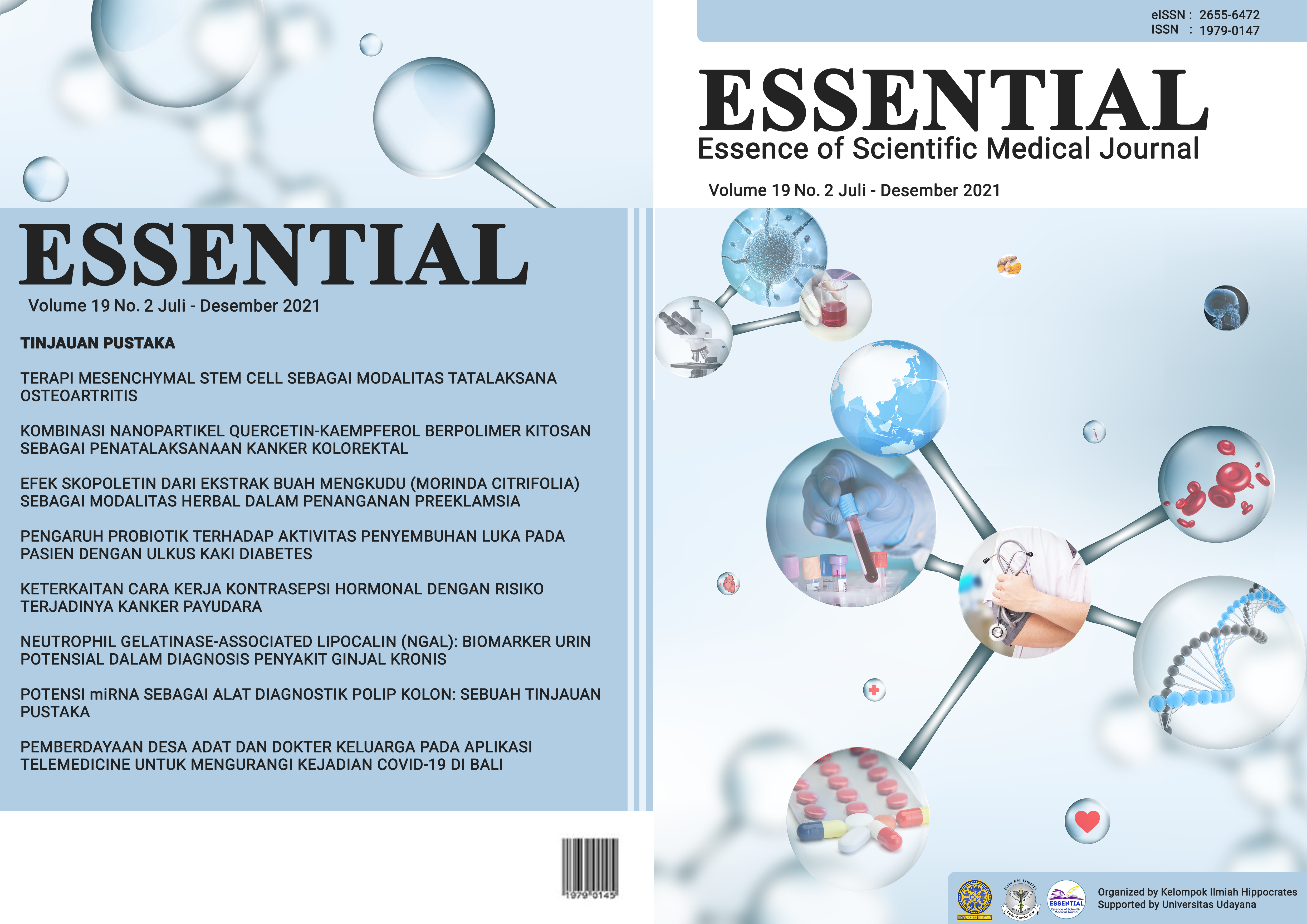Pengaruh Probiotik Terhadap Aktivitas Penyembuhan Luka Pada Pasien Dengan Ulkus Kaki Diabetes
Abstract
Pendahuluan: Insidensi penyakit diabetes semakin meningkat setiap tahunnya. Salah satu komplikasi terkait pneyakit diabetes adalah ulkus kaki diabetes (UKD). Kejadian ulserasi pada UKD dapat diakibatkan oleh timbulnya infeksi bakteri pada luka. Probiotik merupakan mikroorganisme yang telah lama dimanfaatkan dalam produk makanan karena efek menyehatkannya. Tujuan dari tinjauan ini adalah untuk membahas peran probiotik dalam perbaikan kondisi pasien diabetes mellitus tipe 2 dan pengaruh probiotik dalam proses penyembuhan luka pada luka ulkus kaki diabetes.
Pembahasan: UKD dipengaruhi dari penyakit arteri perifer (PAP) dan neuropati pasien diabetes dengan infeksi bakteri yang terjadi pada luka pasien. Probiotik memiliki efek perbaikan kondisi metabolik pasien diabetes dan meningkatkan kemampuan penyembuhan pasien dengan UKD melalui modulasi pada sistem imun untuk meningkatka kemampuan penyembuhan luka pasien.
Simpulan: Probiotik dapat meningkatkan kemampuan penyembuhan pasien UKD. Penelitian lebih lanjut diperlukan untuk meningkatkan keefektifitas probiotik sebagai terapi penyembuhan pada pasien UKD di masa depan.
Downloads
References
2. Alexiadou K, Doupis J. Management of diabetic foot ulcers. Diabetes Ther 2012;3(1):1–15.
3. Hurlow JJ, Humphreys GJ, Bowling FL, McBain AJ. Diabetic foot infection: A critical complication. Int Wound J 2018;15(5):814–21.
4. Uçkay I, Aragón-Sánchez J, Lew D, Lipsky BA. Diabetic foot infections: What have we learned in the last 30 years? Int J Infect Dis 2015;40:81–91.
5. Estelle E, Mathioudakis N. Update on management of diabetic foot ulcers. Ann N Y Acad Sci [Internet] 2018;1411(1):153–165. Available from: https://www.ncbi.nlm.nih.gov/pmc/articles/PMC5793889/pdf/nihms919723.pdf
6. Shi H, Balakrishan K, Thiagarajah K, Ismail N, Yin O. Beneficial Properties of Probiotics. Trop Life Sci Res 2016;27(2):73–90.
7. Amara AA, Shibl A. Role of Probiotics in health improvement, infection control and disease treatment and management. Saudi Pharm J [Internet] 2015;23(2):107–14. Available from: http://dx.doi.org/10.1016/j.jsps.2013.07.001
8. Sánchez B, Delgado S, Blanco-Míguez A, Lourenço A, Gueimonde M, Margolles A. Probiotics, gut microbiota, and their influence on host health and disease. Mol Nutr Food Res 2017;61(1):1–15.
9. Karimi S, Rashidian E, Birjandi M, Mahmoodnia L. Antagonistic effect of isolated probiotic bacteria from natural sources against intestinal Escherichia coli pathotypes. Electron Physician 2018;10(3):6534–9.
10. Upadrasta A, Madempudi RS. Probiotics and blood pressure: Current insights. Integr Blood Press Control 2016;9:33–42.
11. Moulaei K, Malek M, Sheikhtaheri A. Monitoring of external predisposing factors for Diabetic Foot: A literature review and physicians’ perspectives. Med J Islam Repub Iran 2019;33:159.
12. Armstrong DG, Boulton AJM, Bus SA. Diabetic foot ulcers and their recurrence. N Engl J Med 2017;376(24):2367–75.
13. Chun D, Kim S, Kim J, Yang H-J, Kim JH, Cho J, et al. Epidemiology and Burden of Diabetic Foot Ulcer and Peripheral Arterial Disease in Korea. J Clin Med 2019;8(5):748.
14. Pereira SG, Moura J, Carvalho E, Empadinhas N. Microbiota of chronic diabetic wounds: Ecology, impact, and potential for innovative treatment strategies. Front Microbiol 2017;8(SEP):1–12.
15. Smith K, Collier A, Townsend EM, O’Donnell LE, Bal AM, Butcher J, et al. One step closer to understanding the role of bacteria in diabetic foot ulcers: Characterising the microbiome of ulcers. BMC Microbiol [Internet] 2016;16(1):1–12. Available from: http://dx.doi.org/10.1186/s12866-016-0665-z
16. Shanmugam P, Jeya M, Linda SS. The bacteriology of diabetic foot ulcers, with a special reference to multidrug resistant strains. J Clin Diagnostic Res 2013;7(3):441–5.
17. Gardiner M, Vicaretti M, Sparks J, Bansal S, Bush S, Liu M, et al. A longitudinal study of the diabetic skin and wound microbiome. PeerJ 2017;2017(7):3543.
18. Verbanic S, Shen Y, Lee J, Deacon JM, Chen IA. Microbial predictors of healing and short-term effect of debridement on the microbiome of chronic wounds. npj Biofilms Microbiomes [Internet] 2020;6(1):1–11. Available from: http://dx.doi.org/10.1038/s41522-020-0130-5
19. Bitar MS, Al-Mulla F. ROS constitute a convergence nexus in the development of IGF1 resistance and impaired wound healing in a rat model of type 2 diabetes. DMM Dis Model Mech 2012;5(3):375–88.
20. Otranto M, Nascimento AP Do, Monte-Alto-Costa A. Insulin resistance impairs cutaneous wound healing in mice. Wound Repair Regen 2013;21(3):464–72.
21. Moura J, Rodrigues J, Gonçalves M, Amaral C, Lima M, Carvalho E. Impaired T-cell differentiation in diabetic foot ulceration. Cell Mol Immunol 2017;14(9):758–69.
22. Yao K, Zeng L, He Q, Wang W, Lei J, Zou X. Effect of probiotics on glucose and lipid metabolism in type 2 diabetes mellitus: A meta-analysis of 12 randomized controlled trials. Med Sci Monit 2017;23:3044–30453.
23. Koutnikova H, Genser B, Monteiro-Sepulveda M, Faurie JM, Rizkalla S, Schrezenmeir J, et al. Impact of bacterial probiotics on obesity, diabetes and non-alcoholic fatty liver disease related variables: A systematic review and meta-analysis of randomised controlled trials. BMJ Open 2019;9(3):1–12.
24. Vekic J, Zeljkovic A, Stefanovic A, Jelic-Ivanovic Z, Spasojevic-Kalimanovska V. Obesity and dyslipidemia. Metabolism [Internet] 2019;92:71–81. Available from: https://doi.org/10.1016/j.metabol.2018.11.005
25. Firouzi S, Majid HA, Ismail A, Kamaruddin NA, Barakatun-Nisak MY. Effect of multi-strain probiotics (multi-strain microbial cell preparation) on glycemic control and other diabetes-related outcomes in people with type 2 diabetes: a randomized controlled trial. Eur J Nutr 2017;56(4):1535–50.
26. Tonucci LB, Olbrich dos Santos KM, Licursi de Oliveira L, Rocha Ribeiro SM, Duarte Martino HS. Clinical application of probiotics in type 2 diabetes mellitus: A randomized, double-blind, placebo-controlled study. Clin Nutr [Internet] 2017;36(1):85–92. Available from: http://dx.doi.org/10.1016/j.clnu.2015.11.011
27. Asemi Z, Zare Z, Shakeri H, Sabihi SS, Esmaillzadeh A. Effect of multispecies probiotic supplements on metabolic profiles, hs-CRP, and oxidative stress in patients with type 2 diabetes. Ann Nutr Metab 2013;63(1–2):1–9.
28. Raygan F, Rezavandi Z, Bahmani F, Ostadmohammadi V, Mansournia MA, Tajabadi-Ebrahimi M, et al. The effects of probiotic supplementation on metabolic status in type 2 diabetic patients with coronary heart disease IRCT2017082733941N5 IRCT. Diabetol Metab Syndr [Internet] 2018;10(1):1–7. Available from: https://doi.org/10.1186/s13098-018-0353-2
29. Mohseni S, Bayani M, Bahmani F, Tajabadi-Ebrahimi M, Bayani MA, Jafari P, et al. The beneficial effects of probiotic administration on wound healing and metabolic status in patients with diabetic foot ulcer: A randomized, double-blind, placebo-controlled trial. Diabetes Metab Res Rev 2018;34(3).
30. Venegas DP, De La Fuente MK, Landskron G, González MJ, Quera R, Dijkstra G, et al. Short chain fatty acids (SCFAs)mediated gut epithelial and immune regulation and its relevance for inflammatory bowel diseases. Front Immunol 2019;10(MAR).
31. Kesika P, Sivamaruthi BS, Chaiyasut C. Do Probiotics Improve the Health Status of Individuals with Diabetes Mellitus? A Review on Outcomes of Clinical Trials. Biomed Res Int 2019;2019.
32. Khan MIH, Azhar U, Zubair F, Khan ZA. Can we link foot ulcer with risk factors in diabetics? A study in a tertiary care hospital. Pakistan J Med Sci 2018;34(6):1375–80.
33. Xiang J, Wang S, He Y, Xu L, Zhang S, Tang Z. Reasonable Glycemic Control Would Help Wound Healing During the Treatment of Diabetic Foot Ulcers. Diabetes Ther [Internet] 2019;10(1):95–105. Available from: https://doi.org/10.1007/s13300-018-0536-8
34. Spanos K, Saleptsis V, Athanasoulas A, Karathanos C, Bargiota A, Chan P, et al. Factors Associated with Ulcer Healing and Quality of Life in Patients with Diabetic Foot Ulcer. Angiology 2017;68(3):242–50.
35. Kalan LR, Meisel JS, Loesche MA, Horwinski J, Soaita I, Chen X, et al. Strain and species level variation in the microbiome of diabetic wounds is associated with clinical outcomes and therapeutic efficacy. Cell Host Microbe 2019;25(5):641–55.
36. Yu Y, Dunaway S, Champer J, Kim J, Alikhan A. Changing our microbiome: probiotics in dermatology. Br J Dermatol 2020;182(1):39–46.
37. Tsiouris CG, Kelesi M, Vasilopoulos G, Kalemikerakis I, Papageorgiou EG. The efficacy of probiotics as pharmacological treatment of cutaneous wounds: Meta-analysis of animal studies. Eur J Pharm Sci [Internet] 2017;104:230–9. Available from: http://dx.doi.org/10.1016/j.ejps.2017.04.002
38. Lukic J, Chen V, Strahinic I, Begovic J, Lev-Tov H, Davis SC, et al. Probiotics or pro-healers: the role of beneficial bacteria in tissue repair. Wound Repair Regen 2017;25(6):912–22.
39. Catinean A, Neag MA, Mitre AO, Bocsan CI, Buzoianu AD. Microbiota and immune-mediated skin diseases—an overview. Microorganisms 2019;7(9):1–17.
40. Lazarenko LM, Babenko LP, Bubnov R V, Demchenko OM, Zotsenko VM, Boyko N V. Imunobiotics are the novel biotech drugs with antibacterial and immunomodulatory properties. Mikrobiol Zh 2017;7(1):66–75.
41. Villena J, Chiba E, Vizoso-Pinto MG, Tomosada Y, Takahashi T, Ishizuka T, et al. Immunobiotic Lactobacillus rhamnosus strains differentially modulate antiviral immune response in porcine intestinal epithelial and antigen presenting cells. BMC Microbiol 2014;14(1):1–14.
42. Sonal Sekhar M, Unnikrishnan MK, Vijayanarayana K, Rodrigues GS, Mukhopadhyay C. Topical application/formulation of probiotics: Will it be a novel treatment approach for diabetic foot ulcer? Med Hypotheses [Internet] 2014;82(1):86–8. Available from: http://dx.doi.org/10.1016/j.mehy.2013.11.013
43. Mohammedsaeed W, Cruickshank S, McBain AJ, O’Neill CA. Lactobacillus rhamnosus GG Lysate Increases Re-Epithelialization of Keratinocyte Scratch Assays by Promoting Migration. Sci Rep [Internet] 2015;5(November):1–11. Available from: http://dx.doi.org/10.1038/srep16147
44. Ong JS, Taylor TD, Yong CC, Khoo BY, Sasidharan S, Choi SB, et al. Lactobacillus plantarum USM8613 Aids in Wound Healing and Suppresses Staphylococcus aureus Infection at Wound Sites. Probiotics Antimicrob Proteins 2020;12(1):125–37.


 SUBMISSION
SUBMISSION
















